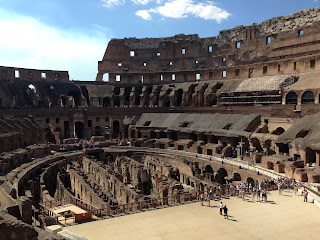 On our way back south through the Italian countryside, we decided we couldn't miss Rome since we were stopping there anyway. I wasn't completely stoked as I thought another big ole dirty city with heaps of tourists, hot and tired from that past week. I mean, what else could top Florence and Venice, right? Boy, was I wrong, I instantly fell in love with Rome too. The size and massiveness, the architecture and art everywhere we turned, every street, nook and cranny, was overwhelming to say the least. I don't know any other city built to such exquisite detail and grandeur. As soon as we found our hotel, dropped our bags, we headed for Trevi Fountain. Wow!
On our way back south through the Italian countryside, we decided we couldn't miss Rome since we were stopping there anyway. I wasn't completely stoked as I thought another big ole dirty city with heaps of tourists, hot and tired from that past week. I mean, what else could top Florence and Venice, right? Boy, was I wrong, I instantly fell in love with Rome too. The size and massiveness, the architecture and art everywhere we turned, every street, nook and cranny, was overwhelming to say the least. I don't know any other city built to such exquisite detail and grandeur. As soon as we found our hotel, dropped our bags, we headed for Trevi Fountain. Wow!Rome's history spans more than 2-1/2 thousand years. While Roman mythology dates the founding of Rome at only around 753 BC, the site has been inhabited much longer, making it one of the oldest continuously occupied sites in Europe. Eventually, the city successively became the capital of the Roman Kingdom, the Roman Republic and the Roman Empire, and is regarded as one of the birthplaces of Western civilization and by some as the first ever metropolis. It is referred to as "Roma Aeterna" (The Eternal City) and "Caput Mundi" (Capital of the World), two central notions in ancient Roman culture.
After the fall of the Western Empire, which marked the beginning of the Middle Ages, Rome slowly fell under the political control of the Papacy, which had settled in the city since the 1st century AD, until in the 8th century it became the capital of the Papal States, which lasted until 1870.
Beginning with the Renaissance, almost all the popes since Nicholas V (1422–55) pursued coherently four hundred years of an architectonic and urbanistic programme aimed to make the city the world's artistic and cultural centre.

Due to that, Rome became first one of the major centres of the Italian Renaissance, and then the birthplace of both the Baroque style and Neoclassicism. Famous artists, painters, sculptors and architects made Rome the centre of their activity, creating masterpieces throughout the city. In 1871 Rome became the capital of the Kingdom of Italy, and in 1946 that of the Italian Republic.
 You can read about Rome, you see it in the movies, you can hear about it, but when you are actually standing there immersed in all the old sites, not to mention all the little alleys and cafes, does it really hit you, what the Romans had done and has endured to this day. It seems as if the Roman Empire was just yesterday. Walking through the forum you can almost hear the vibrant old city, siting in the Coliseum, you can hear the cheers and shouts of that day. And then there's St Peters, the most impressive church I have ever seen, anywhere. And of course, the Vatican's treasure of artefacts they have collected over the years is unsurpassed in any museum.
You can read about Rome, you see it in the movies, you can hear about it, but when you are actually standing there immersed in all the old sites, not to mention all the little alleys and cafes, does it really hit you, what the Romans had done and has endured to this day. It seems as if the Roman Empire was just yesterday. Walking through the forum you can almost hear the vibrant old city, siting in the Coliseum, you can hear the cheers and shouts of that day. And then there's St Peters, the most impressive church I have ever seen, anywhere. And of course, the Vatican's treasure of artefacts they have collected over the years is unsurpassed in any museum. 
After a couple of days, "Roma Aeterna" really sinks in. I love Rome and Italy and if it wasn't for the Schengen insanity, we would have stayed much longer. I certainly envision coming back for a much longer stay.
So that's the news from EQ, where the winds are fair, the seas calm and the crew content.
With Equanimity and Joy...


